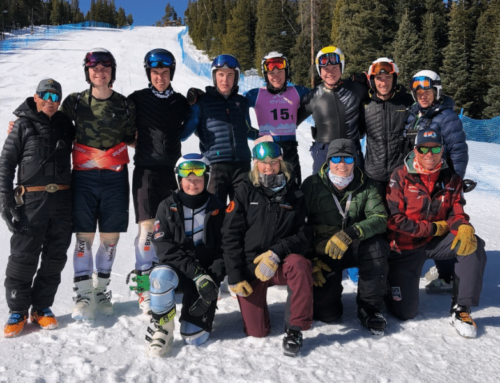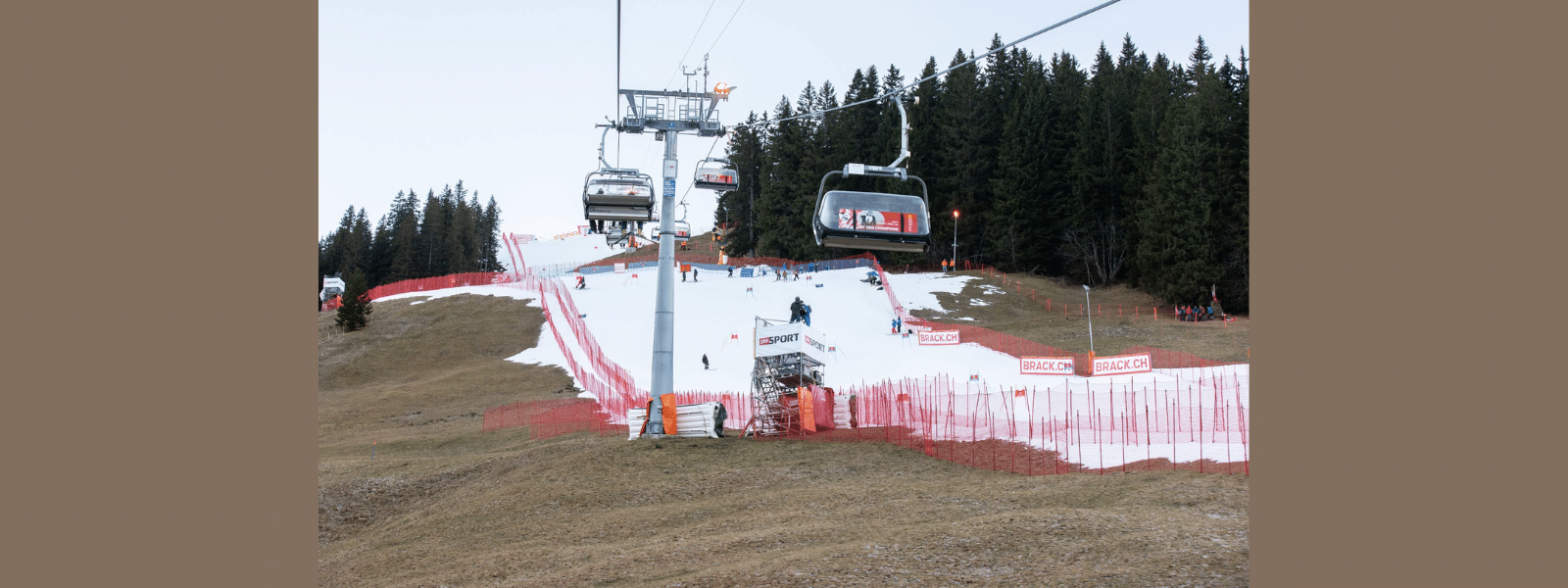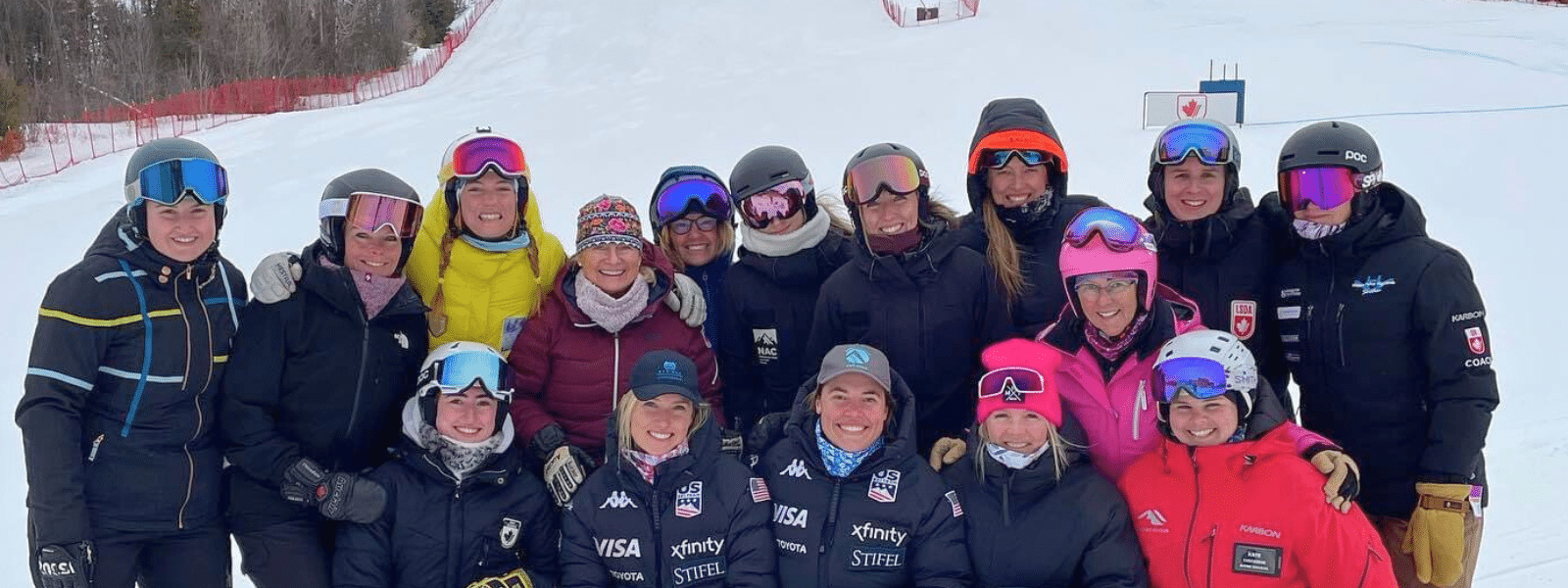Welcome to the USCSA: college ski racing for everyone
Last weekend, Robby Kelley led the Castleton University men’s alpine team in a podium sweep at the St. Anselm College Carnival giant slalom. Kelley’s teammates Paul Rechberger and Logan Mackie finished within a second of him. The previous day, Kelley — a veteran of two FIS world championships and almost three dozen World Cups and now a junior art major at Castleton — won the New England College Carnival slalom. His Spartan teammates would have again swept the podium had Rechberger not crashed second run. The Castleton women were equally successful. And in all four races, Castleton beat Babson College by several seconds — not points.
The Castleton Spartans want to win a national ski championship this year (the women finished second last year, the men third). But you won’t see Castleton listed in the NCAA rankings. The Spartans compete in the United States Collegiate Ski and Snowboard Association — the “other” college ski league, except with hundreds more teams and thousands more participants than NCAA DI skiing. And while racing can be very competitive, depending on the USCSA conference, the USCSA is a come-one, come-all organization that keeps skiers on the hill and introduces the sport to others.
“NCAA racing is awesome and very competitive, but spots are limited,” said Castleton coach Christopher Eder. “If it were not for the USCSA, there would be quite a few ski racers calling it quits after their senior year of high school. Prospective student-athletes with points in the 50s and above have a really good opportunity in the USCSA to continue ski racing and flourish at this level.”
Yet few young alpine skiers or their parents consider USCSA racing — or even know about it. It’s D1 or bust, with many young skiers thinking that their ski-racing days are over after high school if their points are not low enough or if they never went the FIS route. But USCSA racing is far from the beer league, although there’s room for that kind of racing too.
As Tufts University ski team captain Sami Rubin said: “You can take it to whatever level you want, from first-timer in the gates to FIS-level intensity. Being able to have it at all those different levels is really nice.”
I talked to several alpine racers to see what they like — and don’t like — about USCSA racing. Most used the word “fun” multiple times to describe it. Whether it’s the team aspect that is highlighted or the fact that scholarships or future ski-racing careers don’t hang in the balance, everyone had a smile on their face.
“It’s like a big family, we’re all excited to go to races,” said Castleton’s Rechberger. “It’s not just against each other but more like with each other.”
The only complaint: Sometimes it’s hard to focus on ski racing after dancing and joking with teammates.
A little history
First, some background: The USCSA has roots back to 1967 when Holger Petersen, then a sophomore electrical engineering student at Marquette University and head of the university’s outing/sailing club, wanted to facilitate ski racing for some of the club’s 400 members. Thus was born the Wisconsin Intercollegiate Ski Association. Over the ensuing decades, the organization grew to become the National Collegiate Ski Association, and sometime in the 1980s or 1990s, the USCSA.
Today, 193 colleges and universities in 11 conferences across the U.S. have USCSA ski programs, with over 5,000 skiers (both alpine and nordic), freeskiers, and snowboarders participating. While the organization has grown immensely from its Midwestern roots, its mission has remained the same: to promote alpine and cross-country skiing, freesking, and snowboarding for any college or university that wants to start a team, either varsity and club, with or without a coach. And most institutions have the opportunity to qualify for the annual national championship.
Who’s racing?
The most competitive skiers at the USCSA national championship were serious FIS racers in high school who had their eyes on making their national team or a NCAA D1 team. But in the case of two skiers whom I interviewed, knee injuries took them off that track. They still wanted to ski race in college but were concerned that USCSA racing would not be competitive enough.
“Initially, I was really scared about the idea,” said Rubin, an engineering major at Tufts who has twice made it to nationals. “I was really worried that there was not going to be a lot of room for improvement. But everything is really well run, we have coaches, and I have been able to improve so much here.”
Logan Mackie was also on the fast track to race for an NCAA program when he suffered two knee injuries. His older sister, Kylie, convinced him to come to Vermont’s Castleton University, where he’s now a business management major.
“Honestly, coming in to USCSA, I didn’t expect it to be at this high of a level,” said Mackie, who beat Robby Kelley in the second run of GS at the St. Anselm Carnival last weekend, jumping from sixth to third. “But we have so many high caliber athletes coming in that the top teams could basically compete in Division 1.”
For Kylie Mackie, now a senior exercise science major at Castleton, she knew D1 skiing would be a reach. But in USCSA racing, she has competed every weekend during her college career and usually scores for the Spartans.
“Seeing the atmosphere in [USCSA racing] and all the athletes who went to Castleton and how much fun they had with it really drove me to Castleton,” she said.
Robby Kelley chose Castleton as much for the football team as the ski team (he played wide receiver for the Spartans until he broke his arm this fall). He had already completed two years at the University of Vermont before he took off time to compete at the world-class level for Redneck Racing. But at age 29, he was no longer age-eligible for NCAA competition, where age 25 is the limit.
So far, Kelley likes what he’s seen. He has finished on the podium in every race so far this season and won four. Rechberger has been either right behind him or right ahead.
“There’s definitely some really good skiers, definitely a lot of guys who could ski D1, so that’s cool to see,” said Kelley, of the USCSA’s MacConnell division, the most competitive in the Eastern Conference.
Kelley likes that team score is based on accumulated time, not points, which puts a premium on skiing fast.
“It’s not just about if you beat somebody by 0.01 and get first and you get extra points,” he explained. “If you beat someone by 0.01, you only get an extra 0.01 for the win. It rewards fast skiing more than it does on the other circuits.”
Others competing on USCSA teams raced USSA and/or for their high school teams but never considered collegiate skiing — until they got on campus and learned that their schools either had a varsity ski team or ski club competing in USCSA racing.

Rachel Urban raced for the University of Washington for four years and now coaches the Huskie ski team. A former racer who grew up skiing at Squaw Valley, she stopped racing at age 14 to focus on school. But at UW, where she majored in economics and political science, she learned that she could successfully combine the two—ski racing and school—and the team helped her find a niche on UW’s big campus. The Huskies train twice a week in the evenings at nearby Snoqualmie.
“It was a way to continue ski racing, which is something I love, without having to focus on just the performance aspect or having to train five days a week and burn out and ruin it for myself,” she said.
My daughter Sam, who came up through USSA racing but was rarely near the top of the live timing feed, competes for Vassar College and has found a home in the USCSA’s Eastern Conference McBrine Division, where she often finishes on or near the podium. Nevermind that some of her teammates rent skis when they show up for races. They are all having a ball, skiing on the weekends and hanging out together.
Some of Sami Rubin’s favorite moments in USCSA racing are not the time she finished seventh in slalom at nationals, or the many wins she has had in the East’s Thompson division. It’s the races where the entire Tufts team—40 to 50 strong—stand at the bottom and cheer on everyone.
“It’s a really great environment to come down to and also be part of, hyping up and cheering for your teammates,” she said.
Even athletes on the most serious teams keep the fun in ski racing. At Castleton one year, the top racers offered to give up their seeded spots in a race to a teammate who was not as fast but had worked hard every day during his four years on the team. When he crossed the finish line after his second run, his teammates lifted him onto their shoulders.
“It was a cool and unselfish moment,” said Coach Eder. “I was very proud of our guys that day, they put aside their individual goals to see someone else shine. That is what USCSA racing is all about! It is a team effort. You win and lose as a team.”





















